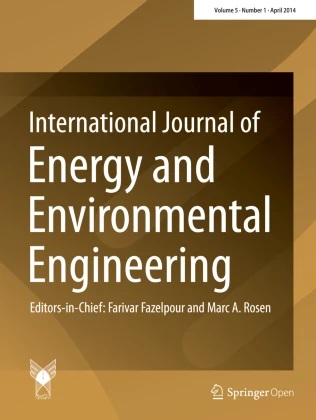Improving the initialization of a stochastic AC-QP optimal power flow algorithm
- Electrical and Computer Engineering Department, Valparaiso University, Valparaiso, IN, 46383, US

Published in Issue 2022-06-10
How to Cite
Piccoli, D., & Marley, J. (2022). Improving the initialization of a stochastic AC-QP optimal power flow algorithm. International Journal of Energy and Environmental Engineering, 14(2 (June 2023). https://doi.org/10.1007/s40095-022-00509-1
Abstract
Abstract As the penetration of renewable generation in electricity networks increases, so does the challenge of maintaining the reliability of those networks. This work utilizes a scenario-based approach to solving a stochastic AC optimal power flow (OPF) problem. In addition to producing an optimal operating point, this method offers a-posteriori theoretical guarantees on the probability of violation for any arbitrary wind scenario that may be encountered in real-time operation. This work expands upon prior formulations by proposing six methods of initializing the stochastic AC-QP OPF algorithm. Results are presented for both the IEEE 14-bus and 3012wp networks; each network was augmented with two wind nodes. The performance of all initialization methods is assessed with regard to the total number of support scenarios, total execution time, and cost of operation. Each is shown to outperform a random initialization process. Trade-offs among these methods with respect to computational complexity and efficacy are also discussed.Keywords
- Renewable generation,
- Forecast uncertainty,
- K-means clustering,
- AC optimal power flow
References
- Wood et al. (2013) John Wiley and Sons Inc
- Motto et al. (2002) Network-constrained multiperiod auction for a pool-based electricity market 17(3) (pp. 646-653) https://doi.org/10.1109/TPWRS.2002.800909
- Overbye, T., Cheng, X., Sun, Y.: A comparison of the AC and DC power flow model for LMP calculations. In: 37th Hawaii international conference on system sciences (HICSS) (2006).
- https://doi.org/10.1109/HICSS.2004.1265164
- Stott et al. (2009) DC power flow revisited 24(3) (pp. 1290-1300) https://doi.org/10.1109/TPWRS.2009.2021235
- Molzahn et al. (2013) Implementation of a large-scale optimal power flow solver based on semidefinite programming 28(4) (pp. 3987-3998) https://doi.org/10.1109/TPWRS.2013.2258044
- Low (2014) Convex relaxation of optimal power flow: parts I & II 1(1) (pp. 15-27) https://doi.org/10.1109/TCNS.2014.2309732
- Bienstock, D., Munoz, G.: On linear relaxations of OPF problems (2015).
- http://arxiv.org/abs/1411.1120
- Coffrin et al. (2016) The QC relaxation: theoretical and computational results on optimal power flow 31(4) (pp. 3008-3018) https://doi.org/10.1109/TPWRS.2015.2463111
- Gan, L., Low, S.H.: Convex relaxations and linear approximation for optimal power flow in multiphase radial networks. In: 18th power system computation conference (PSCC) (2014).
- https://doi.org/10.1109/PSCC.2014.7038399
- Lesieutre, B.C., Molzahn, D.K., Borden, A.R., DeMarco, C.L.: Examining the limits of the application of semidefinite programming to power flow problems. In: 49th annual Allerton conference on communication control and computing, pp. 1492–1499 (2011).
- https://doi.org/10.1109/Allerton.2011.6120344
- Molzahn, D., Lesieutre, B., DeMarco, C.: Investigation of non-zero duality gap solutions to a semidefinite relaxation of the optimal power flow problem. In: 47th Hawaii international conference on system sciences (HICSS) (2014).
- https://doi.org/10.1109/HICSS.2014.293
- Marley et al. (2017) Solving multiperiod OPF problems using an AC-QP algorithm initialized with an SOCP relaxation 32(5) (pp. 3538-3548) https://doi.org/10.1109/TPWRS.2016.2636132
- Bienstock et al. (2014) Chance-constrained optimal power flow: risk-aware network control under uncertainty 56(3) (pp. 461-495) https://doi.org/10.1137/130910312
- Roald, L., Oldewurtel, F., Krause, T., Andersson, G.: Analytical reformulation of security constrained optimal power flow with probabilistic constraints. In: IEEE PowerTech Conference (2013).
- https://doi.org/10.1109/PTC.2013.6652224
- Bertsimas et al. (2013) Adaptive robust optimization for the security constrained unit commitment problem 28(1) (pp. 52-63) https://doi.org/10.1109/TPWRS.2012.2205021
- Vrakopoulou, M., Katsampani, M., Margellos, K., Lygeros, J., Andersson, G.: Probabilistic security-constrained AC optimal power flow. In: IEEE PowerTech Conference (2013).
- https://doi.org/10.1109/PTC.2013.6652374
- Papavasiliou et al. (2011) Reserve requirements for wind power integration: a scenario-based stochastic programming framework 26(4) (pp. 2197-2206) https://doi.org/10.1109/TPWRS.2011.2121095
- Morales et al. (2009) Economic valuation of reserves in power systems with high penetration of wind power 24(2) (pp. 900-910) https://doi.org/10.1109/TPWRS.2009.2016598
- Vrakopoulou, M., Margellos, K., Lygeros, J., Andersson, G.: Probabilistic guarantees for the N-1 security of systems with wind power generation. In: Probabilistic methods applied to power systems conference (2012)
- Marley, J.F., Vrakopoulou, M., Hiskens, I.A.: An AC-QP optimal power flow algorithm considering wind forecast uncertainty. In: IEEE innovative smart grid technologies - Asia, pp. 317–323 (2016).
- https://doi.org/10.1109/ISGT-Asia.2016.7796405
- Campi, M.C., Garatti, S., Ramponi, F.A.: Non-convex scenario optimization with application to system identification. In: 54th IEEE conference on decision and control (2015).
- https://doi.org/10.1109/CDC.2015.7402845
- Calafore and Campi (2006) The scenario approach to robust control design 51(5) (pp. 742-753) https://doi.org/10.1109/TAC.2006.875041
- Alamo, T., Tempo, R., Luque, A.: On the sample complexity of randomized approaches to the analysis and design under uncertainty. In: Proceedings of the American control conference (2010).
- https://doi.org/10.1109/ACC.2010.5531078
- Yang and Sutanto (2019) Chance-constrained optimization for nonconvex programs using scenario-based methods (pp. 157-168) https://doi.org/10.1016/j.isatra.2019.01.013
- Rocchetta et al. (2020) A scenario optimization approach to reliability-based design https://doi.org/10.1016/j.ress.2019.106755
- Hastie et al. (2009) Springer https://doi.org/10.1007/978-0-387-84858-7
- Zimmerman et al. (2011) MATPOWER: steady-state operations, planning, and analysis tools for power systems research and education (pp. 1-8) https://doi.org/10.1109/TPWRS.2010.2051168
- Coffrin, C.: STAC: Steady-state AC network visualization in the browser. Available at https://immersive.erc.monash.edu/stac/ (2017)

 10.1007/s40095-022-00509-1
10.1007/s40095-022-00509-1











